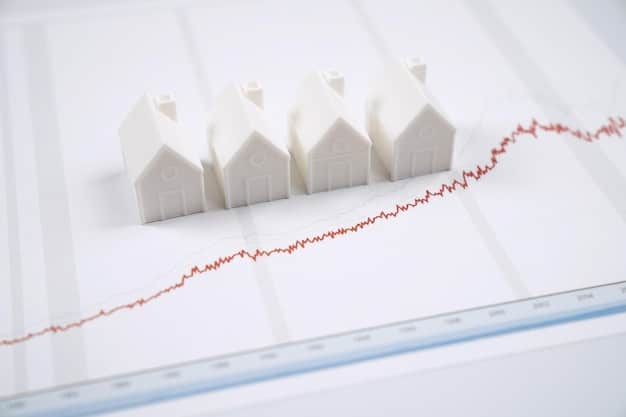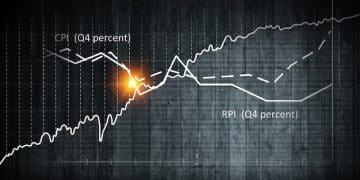The 2025 Housing Market: Crash or Correction? Financial Analysis

The prospect of a housing market crash in 2025 looms, driven by rising interest rates, affordability challenges, and shifting demographic patterns, but expert consensus leans towards a more probable correction rather than a catastrophic collapse, emphasizing regional variations and a resilient underlying demand.
The murmurs of an impending housing market crash have grown louder, captivating homeowners, potential buyers, and investors alike. Will the housing market crash of 2025: Is it really happening? Financial news analysis demands a nuanced look beyond the headlines, evaluating the complex interplay of economic indicators, historical precedents, and expert prognoses to understand if we are on the brink of a systemic collapse or merely a long-overdue, healthy market correction.
Decoding the “Crash”: Understanding Market Dynamics
The term “crash” often evokes images of the 2008 financial crisis, a period marked by widespread foreclosures, plummeting property values, and global economic turmoil. However, a market correction, while still involving price adjustments, typically implies a healthier recalibration, not a collapse. Understanding the distinction is crucial for navigating the current landscape.
The housing market operates on a delicate balance of supply and demand, influenced by a multitude of factors ranging from interest rates and inflation to employment rates and consumer confidence. When these forces become misaligned, the market experiences shifts that can range from minor fluctuations to significant downturns.
Historical context of housing market downturns
Examining past housing cycles offers valuable perspective. The 2008 crash, for instance, was largely fueled by subprime lending practices and excessive risk-taking, creating an artificial demand bubble that eventually burst. Previous downturns, like the early 1990s recession, were often tied to economic slowdowns and higher interest rates, leading to more moderate price declines.
- 2008 Financial Crisis: Characterized by extensive subprime lending, lax regulatory oversight, and a speculative bubble that led to a sharp and prolonged downturn.
- Early 1990s Recession: Primarily influenced by a broader economic slowdown, higher interest rates, and a decline in consumer confidence, leading to a more localized and less severe housing market contraction.
- Late 1970s/Early 1980s: High inflation and soaring interest rates significantly cooled the housing market, making buying prohibitively expensive for many.
- Dot-com Bust (Early 2000s): While not a housing crash per se, the economic uncertainty did impact certain high-tech markets, showcasing localized vulnerabilities.
Current market conditions present a unique mix of historical influences. While mortgage rates have risen significantly from their pandemic lows, lending standards remain relatively tight compared to the pre-2008 era. Supply, while improving, still lags behind demand in many desirable areas, which provides some floor for prices.
Furthermore, the current economic landscape differs considerably. While inflation has been persistent, the broader job market has remained robust, and household balance sheets are generally healthier. This resilience, in part, counters some of the negative pressures seen in previous crises. The housing market is rarely monolithic; regional variations often dictate the extent of price changes.
Key Indicators Pointing to a Potential Downturn
Several economic indicators are currently signaling a potential cooling, if not a full-blown downturn, in the housing market. These signals warrant close attention as they collectively paint a picture of shifting affordability and demand. Understanding these factors is essential for any financial news analysis.
Rising interest rates and affordability crisis
The Federal Reserve’s aggressive interest rate hikes, aimed at taming inflation, have directly impacted mortgage rates. Higher rates significantly increase monthly mortgage payments, thereby eroding purchasing power and making homeownership less accessible for many potential buyers. This rapid escalation in borrowing costs creates an affordability crisis, pushing many out of the market entirely.
- Increased Monthly Payments: Even a slight increase in interest rates can translate to hundreds of dollars more per month on a mortgage, significantly impacting household budgets.
- Reduced Purchasing Power: Buyers qualify for smaller loan amounts, forcing them to look at less expensive homes or re-evaluate their homeownership goals.
- Shrinking Buyer Pool: As affordability wanes, the pool of eligible buyers contracts, leading to less competition for available homes.
This dynamic is particularly challenging for first-time homebuyers who may not have significant equity from a previous home sale. Their ability to enter the market is severely constrained, leading to a build-up of demand as they remain renters.
Inflation and economic uncertainty
Persistent inflation erodes consumer purchasing power across the board. When everyday expenses like groceries, gas, and utilities rise, discretionary income decreases, making large purchases like homes even more challenging. Economic uncertainty, fueled by geopolitical tensions and recession fears, further dampens consumer confidence. People tend to postpone major life decisions, including home purchases, when they are unsure about their financial future or job security.
The interplay of these factors creates a “wait-and-see” mentality among potential buyers, slowing transaction volumes. While inflation can, in theory, protect real estate values as hard assets, the rapid rise in costs coupled with a slowing economy creates a difficult environment for sustained price growth.
Inventory levels and buyer demand shift
After years of historically low inventory, there has been a gradual increase in homes for sale. While still below pre-pandemic levels in many areas, this rise in inventory, combined with a decline in buyer demand (due to affordability issues), shifts market power from sellers to buyers. When there are more homes than eager buyers, prices tend to stabilize or even decline.
This rebalancing of supply and demand is a natural market correction. Buyers have more choices, less pressure to engage in bidding wars, and potentially more room for negotiation. This shift is a key indicator of a cooling market, moving away from the frenzied activity observed in recent years.

Contrasting Views: Why Some Predict a Correction, Not a Crash
While some forewarn of a dramatic collapse, a significant body of expert opinion leans towards a market correction rather than an outright crash. This perspective is grounded in several fundamental differences between the current market and previous downturns, particularly the notorious 2008 crisis. It’s crucial to examine these nuances for comprehensive financial news analysis.
Stronger lending standards and less speculative buying
Unlike the lax lending practices that largely fueled the 2008 bubble, today’s mortgage market is characterized by much stricter underwriting standards. Lenders are requiring higher credit scores, more substantial down payments, and more rigorous income verifications. This means that current homeowners are generally better qualified and less leveraged.
- Reduced Subprime Exposure: The widespread availability of “no-doc” and subprime loans has been largely eliminated, preventing a similar surge in defaults.
- Higher Equity Levels: Many homeowners refinanced at historically low rates during the pandemic, or bought property and have seen significant appreciation, giving them substantial equity cushions against potential price declines. This reduces the likelihood of foreclosures driven by negative equity.
- Owner-Occupant Focus: While investor activity exists, a larger proportion of current home purchases are by owner-occupants, who are less likely to abandon their properties during a downturn than speculative investors.
These factors suggest a more resilient homeowner base, less prone to defaulting en masse, which would be necessary for a crash of 2008’s magnitude.
Persistent housing supply shortage in key areas
Despite recent increases, overall housing inventory remains historically low in many desirable metropolitan areas. Years of underbuilding post-2008 have created a structural supply deficit that skilled labor shortages and high material costs continue to exacerbate. This fundamental imbalance provides a significant floor for prices, cushioning against sharp declines.
Even with softening demand, the sheer scarcity of available homes, particularly affordable ones, means that significant price drops are unlikely across all markets. While some overvalued areas may experience steeper corrections, broad-based declines are less probable where supply remains constrained.
This limited supply acts as a buffer, ensuring that even if buyer demand cools further, there isn’t a massive overhang of homes for sale that would force sellers to drastically cut prices.
Regional variations and market resilience
The US housing market is not a monolith; it comprises hundreds of distinct local markets, each with its own unique supply-demand dynamics, economic drivers, and demographic trends. A “crash” in one region, particularly those that experienced rapid appreciation and are now seeing population outflows, does not necessarily translate to a national phenomenon.
Markets in states with strong job growth and continued population influx, even if they see some cooling, are likely to experience more modest price adjustments or simply a flattening of appreciation. Remote work trends have also diversified demand, spreading it to previously less-explored regions, adding complexity to uniform national predictions.
The ability of certain markets to absorb shocks due to diversified local economies or continued desirability contributes to overall market resilience, mitigating the risk of a widespread, catastrophic crash.
Impact on Homeowners, Buyers, and Investors
The potential shifts in the housing market, whether a correction or a more severe downturn, will undoubtedly have distinct impacts on various stakeholders. Understanding these implications is crucial for homeowners, prospective buyers, and investors navigating the evolving landscape. A comprehensive financial news analysis must address these different perspectives.
For existing homeowners: equity and mobility
Existing homeowners, especially those who purchased before the recent surge in prices or refinanced at historically low rates, generally possess significant equity. This equity acts as a protective buffer against potential price declines. Even if home values soften, many will still retain positive equity, reducing the risk of being underwater on their mortgages.
- Equity Protection: Higher equity insulates homeowners from modest price drops, reducing the likelihood of foreclosure due to negative equity.
- Reduced Mobility: However, homeowners locked into low mortgage rates may be hesitant to sell and buy a new property at significantly higher rates. This “rate lock-in” effect can limit housing market liquidity and reduce overall transaction volume.
- Property Tax Implications: In areas with declining home values, property taxes might eventually adjust downward, but this process often lags market changes.
For those considering selling, timing becomes critical. Listing a home in a cooling market might mean accepting a lower price or longer selling period than recent peak periods. Those without urgent needs to move may choose to stay put, further tightening inventory for entry-level buyers.
For prospective buyers: affordability and opportunity
For prospective homebuyers, particularly first-time buyers, a market correction could present a mixed bag of opportunities and challenges. While declining prices might seem appealing, the accompanying higher interest rates can still make homeownership financially prohibitive.
However, reduced competition and more negotiating power could be beneficial. The frenzied bidding wars of recent years are becoming less common, allowing buyers more time to make decisions and conduct thorough inspections.
- Affordability Remains a Hurdle: Even with price reductions, higher mortgage rates continue to challenge overall affordability. The total monthly payment can still be higher than during peak price periods with lower rates.
- Increased Negotiation Power: Buyers may find more room to negotiate on price, repairs, and contingencies, reversing the seller-favored conditions of the past few years.
- More Inventory and Choice: A cooling market typically means more homes come onto the market and stay longer, offering buyers a wider selection and less pressure to compromise.
Patience and strategic financial planning are key for buyers in this environment. Waiting for rates to stabilize or for more substantial price adjustments could pay off, but it also carries the risk of missing out if the market rebounds unexpectedly.
For real estate investors: risk and reward
Real estate investors face increased risk in a cooling market, especially if they are highly leveraged or depend on quick appreciation. Rental income stability becomes paramount if property values stagnate or decline. However, a downturn can also create opportunities for cash-rich investors to acquire assets at a discount.
Specific strategies will depend on the investor’s risk tolerance, time horizon, and specific market focus. Flipping properties, for instance, becomes riskier due to the potential for declining sales prices and longer holding periods. Long-term buy-and-hold strategies, especially for rental properties in demand areas, may still be viable, provided the rental yields justify the investment and expenses.
Diligent financial news analysis, including detailed local market research and stress-testing potential returns against higher interest rates and slower appreciation, is essential for investors considering moves in the current environment.
Navigating the Uncertainty: Strategies for All Stakeholders
Given the nuanced and evolving nature of the housing market, adopting proactive and informed strategies is essential for homeowners, prospective buyers, and investors alike. Uncertainty can be daunting, but a thoughtful approach based on sound financial analysis can lead to more favorable outcomes, whether the market experiences a crash or a correction.
Advice for homeowners: assess, protect, and adapt
For current homeowners, the primary focus should be on safeguarding equity and maintaining financial stability. This involves understanding your personal financial situation in detail and being prepared for various scenarios.
- Assess Your Equity: Regularly check your home’s estimated value and compare it to your mortgage balance. A strong equity position provides a buffer against market fluctuations.
- Fortify Your Finances: Build an emergency fund to cover mortgage payments and other living expenses for several months. Review your budget and look for areas to reduce unnecessary spending.
- Consider Refinancing (if advantageous): If rates drop in the future, or Adjustable Rate Mortgages (ARMs) become a concern, consider refinancing to a fixed-rate mortgage if it improves your financial position or reduces risk.
- Maintain Your Property: Well-maintained homes tend to hold their value better even in softer markets. Address deferred maintenance to ensure your property remains attractive if you eventually decide to sell.
If selling is a consideration, be realistic about current market values and be prepared for potentially longer selling times or less competitive offers than during the peak of the recent boom.
Advice for prospective buyers: patience, preparation, and due diligence
Prospective buyers should adopt a cautious yet proactive approach. While the urge to wait for perfect conditions is strong, missing opportunities is also a risk. The key is to be thoroughly prepared and execute due diligence.
- Strengthen Your Finances: Prioritize improving your credit score, paying down debt, and saving for a larger down payment. This will position you for better loan terms when you are ready to buy.
- Get Pre-Approved: Understanding exactly how much house you can afford at current interest rates is critical. A pre-approval also signals to sellers that you are a serious buyer.
- Educate Yourself on Local Markets: The national housing market is an aggregate of thousands of local markets. Research specific neighborhoods, understand local supply-demand dynamics, and identify areas that align with your long-term goals.
- Be Patient but Prepared to Act: Don’t rush into a purchase out of FOMO (fear of missing out). However, when the right opportunity arises in a market that fits your criteria, be ready to move quickly with your pre-approval in hand.
Don’t overlook the importance of a thorough home inspection, and consider negotiating for seller concessions, which are becoming more common in a cooling market.
Advice for real estate investors: strategic re-evaluation and diversification
For real estate investors, the current environment demands a strategic re-evaluation of portfolios and investment theses. The days of guaranteed rapid appreciation are likely over, at least for the short term.
- Re-Evaluate Existing Portfolios: Review the performance of your current properties. Are they meeting cash flow targets? Are their values holding steady? Consider divesting underperforming assets.
- Focus on Cash Flow: In a market with slower appreciation, strong and consistent rental income becomes even more critical. Prioritize properties that generate healthy cash flow.
- Explore Commercial Opportunities: While residential may be slowing, opportunities might emerge in specific commercial real estate sectors, or alternative investments might prove more appealing.
- Diversify Within Real Estate: Consider diversifying across different property types (residential, multifamily, commercial) or geographic locations to spread risk.
Now is a time for meticulous due diligence, conservative underwriting, and a long-term perspective. Chasing quick returns in a volatile market can lead to significant losses. Focus on robust, well-researched investments that can withstand periods of market uncertainty.
Considering Alternative Scenarios and Long-Term Outlook
While the focus often turns to immediate market movements, a comprehensive financial news analysis necessitates considering alternative scenarios beyond a simple “crash or no crash” dichotomy. The long-term outlook for the housing market is shaped by fundamental demographic shifts, economic resilience, and evolving societal preferences.
The “soft landing” scenario and plateauing prices
Many experts predict a “soft landing” for the housing market. This scenario suggests that property values will not crash but rather experience a period of stagnation or modest single-digit declines in most areas, followed by a plateau. This outcome would be characterized by:
- Price Corrections, Not Collapses: Overvalued markets might see 5-15% price drops from their peak, while others might simply see flat prices for a few years.
- Stabilizing Interest Rates: The Federal Reserve might eventually pause or even slightly cut interest rates once inflation is under control, providing some relief for borrowing costs.
- Increased Inventory, but Not a Flood: More homes will come to market, but not enough to overwhelm demand, keeping price declines moderate.
- Balanced Market: A shift from an extreme seller’s market to a more balanced environment where buyers and sellers have relatively equal footing.
This soft landing would allow the market to absorb the rapid appreciation of recent years, recalibrate affordability, and set the stage for more sustainable, albeit slower, growth in the future. It’s a scenario that avoids widespread economic distress while still addressing market imbalances.
Demographic shifts and continued demand
Underlying the short-to-medium term fluctuations are powerful demographic trends that suggest continued long-term demand for housing. The largest generation, millennials, are now firmly in their prime homebuying years, and Gen Z is beginning to enter the market. While high prices and rates have delayed homeownership for many, the fundamental desire for a home remains strong.
Furthermore, population growth, even if slowing, coupled with ongoing household formation, means a consistent need for housing units. While some may currently be priced out, this pent-up demand could re-enter the market once affordability improves or rates become more favorable. The supply side, still constrained by construction costs and labor shortages, further supports the idea that structural demand will eventually soak up available inventory.
These demographic tailwinds, coupled with the long-term preference for homeownership as a means of wealth building, suggest that any current downturn may be temporary, followed by a gradual return to growth.
Adaptation to new economic realities
The housing market, like the broader economy, often adapts to new realities. This includes lessons learned from previous crises and ongoing innovations. For example, while remote work initially drove demand for larger homes in suburban and rural areas, its continued evolution could reshape urban planning and housing preferences, leading to different demand patterns.
Furthermore, policymakers and financial institutions are likely to be more cautious regarding lending practices moving forward, aiming to prevent the kind of speculative excesses that characterized the 2008 run-up. This adaptation to a more regulated and potentially more conservative environment contributes to a more stable, albeit slower, housing market in the long run.
The market’s ability to absorb changes, from interest rate hikes to global economic shifts, indicates a resilience that often prevents catastrophic outcomes, favoring adjustment and recalibration over collapse.

The Role of Government Policy and Global Economy
The complex interplay of government policy and the global economic landscape cannot be overlooked when analyzing the potential trajectory of the housing market. These external factors can significantly influence affordability, construction, and consumer confidence, either exacerbating or mitigating the impact of an economic downturn. A thorough financial news analysis must consider these broader influences.
Federal Reserve’s impact on interest rates and inflation
The Federal Reserve’s monetary policy decisions, particularly regarding interest rates, are arguably the most direct and immediate influence on the housing market. The Fed’s primary tool to combat inflation is raising the federal funds rate, which in turn influences broader borrowing costs, including mortgage rates.
- Higher Mortgage Rates: As the Fed raises rates, the cost of borrowing for home loans increases, directly impacting affordability and reducing buyer demand.
- Controlling Inflation: While painful in the short term for the housing market, the Fed’s efforts to control inflation are crucial for long-term economic stability. Persistent high inflation erodes purchasing power and creates economic uncertainty, which would ultimately harm the housing market even more severely.
- Quantitative Tightening: Beyond interest rates, the Fed’s balance sheet reduction (quantitative tightening) also reduces liquidity in the financial system, which can put additional upward pressure on long-term rates.
The Fed’s actions are a delicate balancing act, aiming to cool the economy sufficiently to tame inflation without triggering a recession that would severely impact employment and housing demand. Their future decisions, guided by incoming economic data, will continue to be a dominant factor for the housing market.
Government housing policies and initiatives
Beyond monetary policy, specific government housing policies and initiatives can also shape market dynamics. These range from first-time homebuyer programs and affordable housing initiatives to zoning regulations and infrastructure spending.
Policies aimed at increasing housing supply, for example, could alleviate the long-term inventory shortage, contributing to more stable prices. Conversely, overly restrictive zoning laws in high-demand areas can exacerbate supply constraints, pushing prices higher. Government-backed mortgage programs (like FHA and VA loans) also play a crucial role in enabling access to homeownership for various segments of the population.
Recent policy discussions have focused on incentivizing construction and addressing housing affordability, recognizing the social and economic importance of accessible housing. The effectiveness and scale of these initiatives will impact the market’s ability to rebalance.
Global economic conditions and investor sentiment
The US housing market is not entirely immune to global economic conditions. International investors, for example, can contribute significantly to demand in certain luxury or high-growth markets. A global economic slowdown, geopolitical instability, or shifts in investor sentiment towards riskier assets can influence foreign investment in US real estate.
Furthermore, supply chain disruptions, which often have international roots, can impact the cost and availability of building materials, affecting new construction. A stronger or weaker US dollar can also influence the attractiveness of US real estate to international buyers.
While the US housing market is primarily driven by domestic factors, a severe global recession or significant geopolitical event could amplify any existing vulnerabilities or alter investor behavior, thereby influencing demand and capital flows within the real estate sector. Therefore, a holistic financial news analysis must include these broader considerations.
| Key Point | Brief Description |
|---|---|
| 📊 Market Outlook | Experts mostly anticipate a correction, not a crash, due to strong fundamentals. |
| 💰 Affordability Concern | Rising interest rates significantly impact purchasing power, limiting buyers. |
| 🏡 Supply & Demand | Inventory is increasing, but a long-term shortage provides price support. |
| ⚙️ Lending Standards | Stricter rules mean fewer risky loans, reducing systemic risk compared to 2008. |
Frequently Asked Questions About the 2025 Housing Market
▼
While some forecasts suggest price declines, a widespread “crash” like 2008 is unlikely. Most experts predict a correction or normalization, where prices stabilize or experience modest single-digit declines in overvalued areas. Factors like stricter lending standards and continued, albeit suppressed, demand temper the risk of a severe collapse.
▼
Key indicators include rising mortgage interest rates, which directly impact affordability, persistent inflation eroding purchasing power, and a gradual increase in housing inventory. These factors collectively contribute to a cooling of buyer demand, shifting the market dynamics away from the intense competition seen in recent years.
▼
Rising interest rates significantly increase the cost of borrowing for homebuyers, leading to higher monthly mortgage payments. This reduces potential buyers’ purchasing power, forcing them to either consider smaller, less expensive homes or postpone homeownership altogether. This effect contributes significantly to the current affordability crisis.
▼
No, there are fundamental differences. The 2008 crisis was largely fueled by predatory lending practices and widespread subprime mortgages. Today’s lending standards are much stricter, and homeowners generally have more equity. While price corrections are possible, the systemic risks present in 2008 are largely absent.
▼
Prospective homebuyers should prioritize strengthening their financial position, including improving credit and saving for a substantial down payment. Getting pre-approved for a mortgage is crucial. Patience, thorough research into local market conditions, and a willingness to conduct diligent due diligence on properties are also essential strategies.
Conclusion
The housing market’s trajectory towards 2025 remains a subject of intense debate, but a balanced financial news analysis suggests a nuanced future rather than a catastrophic “crash.” While rising interest rates and affordability challenges are undeniably creating headwinds, stronger lending standards, persistent supply shortages in key areas, and a more resilient homeowner base distinguish the current landscape from the systemic vulnerabilities of 2008. The most probable scenario points to a correction, characterized by a return to more sustainable appreciation rates or modest price declines in overvalued regions. For homeowners, buyers, and investors, the imperative is clear: stay informed, adapt strategies to local market realities, and prioritize financial prudence to navigate the evolving real estate environment successfully.





